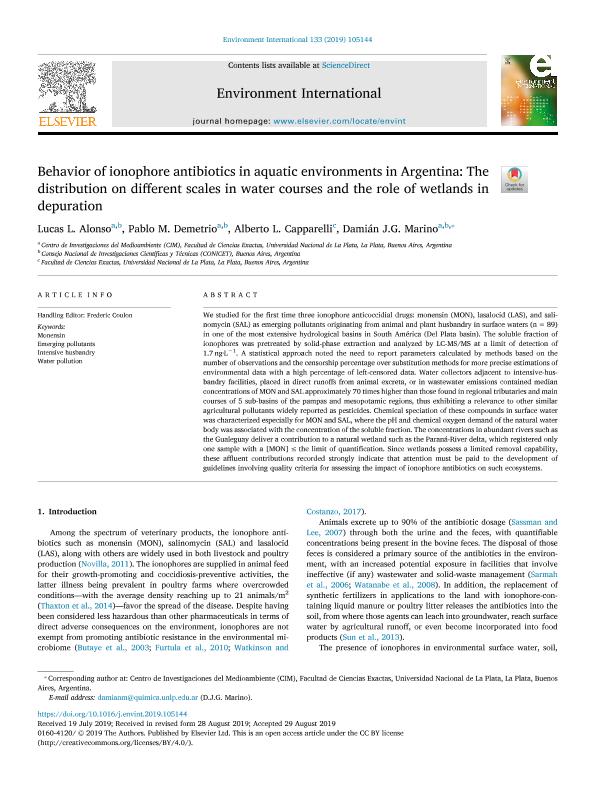Mostrar el registro sencillo del ítem
dc.contributor.author
Alonso, Lucas Leonel

dc.contributor.author
Demetrio, Pablo Martin

dc.contributor.author
Capparelli, Alberto Luis

dc.contributor.author
Marino, Damian Jose Gabriel

dc.date.available
2021-02-05T18:36:14Z
dc.date.issued
2019-12
dc.identifier.citation
Alonso, Lucas Leonel; Demetrio, Pablo Martin; Capparelli, Alberto Luis; Marino, Damian Jose Gabriel; Behavior of ionophore antibiotics in aquatic environments in Argentina: The distribution on different scales in water courses and the role of wetlands in depuration; Pergamon-Elsevier Science Ltd; Environment International; 133; 105144; 12-2019; 1-9
dc.identifier.issn
0160-4120
dc.identifier.uri
http://hdl.handle.net/11336/124977
dc.description.abstract
We studied for the first time three ionophore anticoccidial drugs: monensin (MON), lasalocid (LAS), and salinomycin (SAL) as emerging pollutants originating from animal and plant husbandry in surface waters (n = 89) in one of the most extensive hydrological basins in South América (Del Plata basin). The soluble fraction of ionophores was pretreated by solid-phase extraction and analyzed by LC-MS/MS at a limit of detection of 1.7 ng·L−1. A statistical approach noted the need to report parameters calculated by methods based on the number of observations and the censorship percentage over substitution methods for more precise estimations of environmental data with a high percentage of left-censored data. Water collectors adjacent to intensive-husbandry facilities, placed in direct runoffs from animal excreta, or in wastewater emissions contained median concentrations of MON and SAL approximately 70 times higher than those found in regional tributaries and main courses of 5 sub-basins of the pampas and mesopotamic regions, thus exhibiting a relevance to other similar agricultural pollutants widely reported as pesticides. Chemical speciation of these compounds in surface water was characterized especially for MON and SAL, where the pH and chemical oxygen demand of the natural water body was associated with the concentration of the soluble fraction. The concentrations in abundant rivers such as the Gualeguay deliver a contribution to a natural wetland such as the Paraná-River delta, which registered only one sample with a [MON] ≤ the limit of quantification. Since wetlands possess a limited removal capability, these affluent contributions recorded strongly indicate that attention must be paid to the development of guidelines involving quality criteria for assessing the impact of ionophore antibiotics on such ecosystems.
dc.format
application/pdf
dc.language.iso
eng
dc.publisher
Pergamon-Elsevier Science Ltd

dc.rights
info:eu-repo/semantics/openAccess
dc.rights.uri
https://creativecommons.org/licenses/by/2.5/ar/
dc.subject
EMERGING POLLUTANTS
dc.subject
INTENSIVE HUSBANDRY
dc.subject
MONENSIN
dc.subject
WATER POLLUTION
dc.subject.classification
Ciencias Medioambientales

dc.subject.classification
Ciencias de la Tierra y relacionadas con el Medio Ambiente

dc.subject.classification
CIENCIAS NATURALES Y EXACTAS

dc.title
Behavior of ionophore antibiotics in aquatic environments in Argentina: The distribution on different scales in water courses and the role of wetlands in depuration
dc.type
info:eu-repo/semantics/article
dc.type
info:ar-repo/semantics/artículo
dc.type
info:eu-repo/semantics/publishedVersion
dc.date.updated
2020-12-16T16:09:35Z
dc.journal.volume
133
dc.journal.number
105144
dc.journal.pagination
1-9
dc.journal.pais
Estados Unidos

dc.description.fil
Fil: Alonso, Lucas Leonel. Universidad Nacional de La Plata. Facultad de Ciencias Exactas. Departamento de Química. Centro de Investigaciones del Medio Ambiente; Argentina. Consejo Nacional de Investigaciones Científicas y Técnicas. Centro Científico Tecnológico Conicet - La Plata; Argentina
dc.description.fil
Fil: Demetrio, Pablo Martin. Universidad Nacional de La Plata. Facultad de Ciencias Exactas. Departamento de Química. Centro de Investigaciones del Medio Ambiente; Argentina. Consejo Nacional de Investigaciones Científicas y Técnicas. Centro Científico Tecnológico Conicet - La Plata; Argentina
dc.description.fil
Fil: Capparelli, Alberto Luis. Consejo Nacional de Investigaciones Científicas y Técnicas. Centro Científico Tecnológico Conicet - La Plata; Argentina. Universidad Nacional de La Plata; Argentina
dc.description.fil
Fil: Marino, Damian Jose Gabriel. Consejo Nacional de Investigaciones Científicas y Técnicas. Centro Científico Tecnológico Conicet - La Plata; Argentina. Universidad Nacional de La Plata; Argentina
dc.journal.title
Environment International

dc.relation.alternativeid
info:eu-repo/semantics/altIdentifier/doi/http://dx.doi.org/10.1016/j.envint.2019.105144
dc.relation.alternativeid
info:eu-repo/semantics/altIdentifier/url/https://www.sciencedirect.com/science/article/pii/S0160412019325280?via%3Dihub
Archivos asociados
